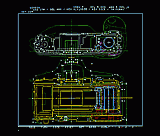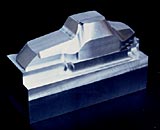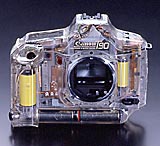Although the design and the engineering/manufacturing departments had been closely associated, even stronger ties between the departments were indispensable for the development of the T90. Computer-aided design (CAD) was introduced for mechanical design, which required designers and engineers to examine and correct the design images on the computer display simultaneously, rather than reviewing the design drawings on blueprints.
At that time, engineering plastics were already in use for many exterior parts of the camera body and it was necessary to define the shape of these parts by converting them to numerical values in order to form accurate molding dies. In particular, it took great pains to define numerically the curved form of the pentaprism cover that was essential for the Colani design, and make the production model. In order to realize the delicately curved surface, there was continual revision of programs for the numerically controlled (NC) processing machines, the blocks of aluminum being shaved after each revision. All the designer and the NC programmer in the metal mold section jointly worked on it, yet, it was impossible to convert the every detail of the model shape into the numeric data perfectly. Finally, the model was manually re-fabricated again and again to reach the final and ideal form of the molding master.
|





 |
Colani’s participation as an outside designer facilitated the collaboration between the design and the engineering/manufacturing departments, which contributed to bring a change on their way of thinking. In the past, the engineering department believed stubbornly “we know how to design a camera!” On the other hand, the manufacturing department said, “we cannot do anymore than we are doing.” The development of the T90 eliminated the friction between them. |
|


